Composite Decking
2024 Free Comprehensive Guide to Composite Decking: Everything You Need to Know
The Best Composite Decking in 2024
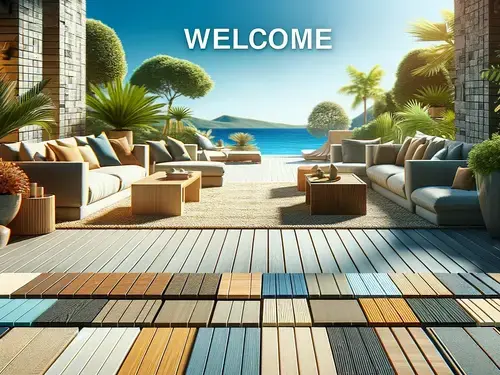
This is the comprehensive FREE guide to composite decking, presented by MTN-2House, Studio7+, Build & Co USA, Altardecks (ca) and Schwanger Development Canada.
Our aim is to equip you with all the essential knowledge about composite decking, covering its fundamentals, design considerations, installation processes, maintenance, and troubleshooting. Whether you're a seasoned professional seeking to enhance your expertise or a homeowner embarking on a new project, this guide is crafted to be clear, concise, and readily accessible. Let's explore everything about composite decking together, looking at its benefits, challenges, and best practices.
Course Modules

Module 1: Introduction to Composite Decking
Overview
Start here to understand what composite decking is, its components, and why it's a popular choice for outdoor spaces. This section sets the stage for the rest of the course.
Key Topics
- Definition of Composite Decking
- The Benefits of Using Composite Materials
- Comparison with Traditional Wood Decking
Introduction
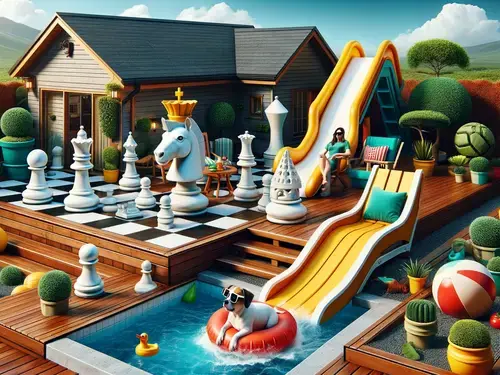
Welcome to our comprehensive guide on composite decking. This module is designed to introduce you to what composite decking is, its key components, and the reasons it has become a go-to option for outdoor spaces. Whether you're planning to upgrade your backyard or are simply curious about modern decking options, this section will provide you with a solid foundation.
What is Composite Decking?
Composite decking is a durable and low-maintenance alternative to traditional wood decking. It's made from a blend of wood fibers and plastics, which results in a product that combines the best features of both materials.
The Components of Composite Decking
Composite decking materials are typically made from a mix of recycled wood fibers and recycled plastics. This blend is then formed into boards through a manufacturing process that ensures the final product is robust and resistant to the elements.
The Benefits of Using Composite Materials
Choosing composite decking comes with several advantages over traditional wood. Here are some key benefits:
- Durability: Composite decks are resistant to fading, staining, scratching, and mold, making them last longer than wood decks.
- Low Maintenance: Unlike wood, composite decking doesn't require regular staining, sealing, or sanding. A simple cleaning with soap and water is usually enough.
- Eco-Friendly: Many composite decking materials are made from recycled wood and plastic, reducing waste and the need for new materials.
- Variety: Composite decking comes in a range of colors and textures, giving you the flexibility to match your outdoor decor.
Comparison with Traditional Wood Decking
While traditional wood decking has been a popular choice for decades, composite decking offers a modern alternative that addresses many of wood's drawbacks. Here's a brief comparison:
- Maintenance: Wood decking requires annual maintenance, including staining and sealing, to protect against weather and wear. Composite decking, on the other hand, needs minimal upkeep.
- Durability: Wood is prone to fading, splintering, and rotting over time, especially in harsh weather conditions. Composite materials are designed to withstand these challenges more effectively.
- Cost: Initially, composite decking can be more expensive than wood. However, when considering the long-term savings on maintenance and replacement, composite decking often proves to be a cost-effective choice.
- Environmental Impact: Composite decking's use of recycled materials can make it a more environmentally friendly option than new, pressure-treated wood boards.
Key Takeaways on Composite Decking
In this module, we've introduced composite decking, highlighted its benefits, and compared it with traditional wood decking. Key points include:
- Composite decking combines wood fibers and plastics for durability and low maintenance.
- It offers significant advantages over wood, including reduced upkeep and a longer lifespan.
- While the upfront cost may be higher than wood, the long-term savings and environmental benefits make it a compelling choice for outdoor spaces.
With this foundation, you're well-equipped to explore further into the world of composite decking, including installation techniques, design possibilities, and maintenance tips.
Next, we'll explore the history and evolution of composite decking materials, understanding how they've become a go-to choice for durability and sustainability.
Module 2: The History and Evolution of Composite Decking
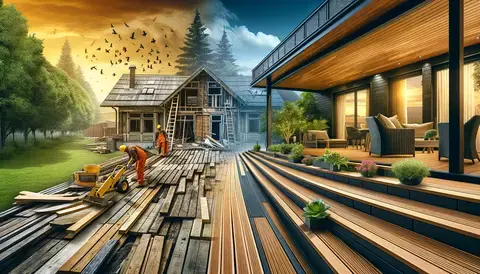
Overview
Learn about the origins of composite decking materials, their development over the years, and how technological advancements have shaped their current state.
Key Topics
- Early Beginnings of Composite Materials
- Technological Advances in Composite Decking
- The Shift Towards Eco-friendly Building Materials
Evolution of Composite Decking
In this section, we dive into the history of composite decking materials, tracing their development from early beginnings to the present day. We'll explore how technological advancements and a growing emphasis on sustainability have played a pivotal role in shaping the modern composite decking industry.
Early Beginnings of Composite Materials
Composite decking materials didn't appear out of thin air. Their development is rooted in the broader history of composite materials, which have been used in various forms for thousands of years. Historically, composites were made from straw and mud to create stronger building materials—a primitive yet effective example. However, the idea of combining wood fibers with plastics to create a building material for decking is relatively modern, originating in the late 20th century.
The First Generation of Composite Decking
The first generation of composite decking emerged in the 1990s. These early products combined recycled wood chips or sawdust with recycled plastic. The goal was to create a material that was more durable and weather-resistant than traditional wood, while also being more environmentally friendly.
Technological Advances in Composite Decking
Over the years, the composite decking industry has seen significant technological advancements. These improvements have not only enhanced the durability and appearance of composite decking but have also made it more versatile and easier to install.
Improvements in Durability and Aesthetics
Early composite decks faced challenges such as fading, staining, and moisture absorption. Thanks to technological innovations, modern composite decking is far more resistant to these issues. Manufacturers have introduced high-performance outer shells and improved composite blends, which offer enhanced UV protection, better color retention, and increased resistance to the elements.
Installation and Maintenance Innovations
Technological advancements have also simplified the installation and maintenance of composite decking. Hidden fastening systems have been developed, allowing for a cleaner and more aesthetic deck surface. Furthermore, the latest composite materials are easier to clean and require less maintenance than both their predecessors and traditional wood decking.
The Shift Towards Eco-friendly Building Materials
In recent years, there has been a significant shift towards eco-friendly and sustainable building materials in the construction industry. This shift has further propelled the popularity and development of composite decking.
Use of Recycled Materials
One of the key features of modern composite decking is its use of recycled wood and plastic materials. This not only reduces waste but also minimizes the need for new raw materials. Many manufacturers now highlight the percentage of recycled content in their products, appealing to environmentally conscious consumers.
Sustainable Manufacturing Practices
Alongside the use of recycled materials, there's a growing focus on sustainable manufacturing practices within the composite decking industry. Companies are striving to reduce their carbon footprint, improve energy efficiency, and minimize the environmental impact of their production processes.
Key Takeaways on the Evolution of Composite Decking
- The development of composite decking materials is part of a long history of using composite materials for building.
- Technological advancements have significantly improved the durability, aesthetics, and ease of installation and maintenance of composite decking.
- There's a growing emphasis on sustainability in the decking industry, with a focus on using recycled materials and adopting eco-friendly manufacturing practices.
This overview of the origins and development of composite decking highlights how innovation and sustainability have driven the industry forward, resulting in the high-quality, eco-friendly decking options available today.
Next, we delve into the design and architectural aspects of composite decking, focusing on modern design features that cater to contemporary homes.
Module 3: Designing with Composite Decking
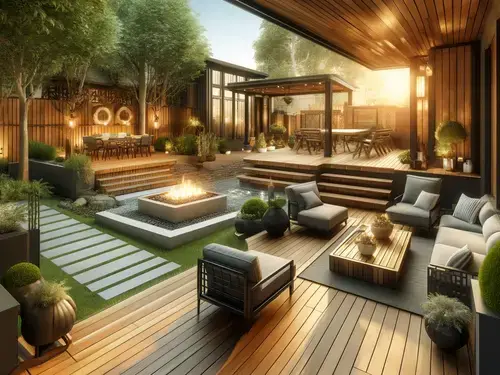
Overview
This module covers the aesthetic and functional design considerations when working with composite decking, including modern trends and how they integrate with contemporary architecture.
Key Topics
- Design Flexibility with Composite Decking
- Modern Design Trends for Outdoor Spaces
- Integrating Composite Decking in Contemporary Homes
With the design aspects covered, we move on to the practical side of things: choosing the right materials for your project.
Module 4: Choosing the Right Composite Decking
Overview
Selecting the right composite decking involves understanding the different types available, their characteristics, and what makes one choice better suited for a specific project than another.
Key Topics
- Types of Composite Decking Materials
- Factors to Consider When Choosing Composite Decking
- Sustainability and Environmental Impact
After selecting your materials, the next step is understanding how to install them correctly.
Module 5: Installing Composite Decking

Overview
Installation is crucial for the longevity and appearance of your decking. This module guides you through the step-by-step process of installing composite decking.
Key Topics
- Preparing the Installation Site
- Step-by-Step Installation Guide
- Common Installation Mistakes and How to Avoid Them
With the decking installed, maintaining its appearance and integrity is next.
Module 6: Maintaining and Repairing Composite Decking

Overview
Maintenance is simpler with composite decking, but there are still best practices to follow. This module covers everything from routine cleaning to repairing damage.
Key Topics
- Routine Maintenance Tips
- Cleaning and Stain Removal
- Repair Techniques for Composite Decking
We conclude with a recap of what we've learned and consider the lasting impact and future trends in composite decking.
Module 7: In-Depth Review Courses for Specific Areas Related to Composite Decking
Efficiently categorize topics to help understand various aspects of composite decking and its products.
This list covers key categories like materials, brands, features, installation components, design considerations, and functionality. It aims to provide a comprehensive yet user-friendly guide, particularly for educational or informational purposes, ensuring clarity and accessibility.
Composite Decking Materials
- Composite Decking: Durable, low-maintenance alternative to wood.
- Composite Decking Boards: Standard units for deck construction, varied specs.
- Solid Composite Decking: Dense boards, no hollow sections, enhanced strength.
- Grey Composite Decking: Modern look with various shades of grey.
- Black Composite Decking: Bold, deep black for sophisticated designs.
- White Composite Decking: Bright and clean appearance, white boards.
- Brown Composite Decking: Classic look with natural brown tones.
- Beige Composite Decking: Neutral, soft beige for light-themed outdoor spaces.
- Blue Composite Decking: Unique, vibrant blue for standout designs.
- Red Composite Decking: Warm, inviting with rich red tones.
- Dark Grey Composite Decking: Contemporary, sophisticated dark grey shades.
- Anthracite Composite Decking: Deep grey with metallic sheen, industrial edge.
- Cedar Composite Decking: Cedar-look without the maintenance, natural beauty.
- Walnut Composite Decking: Mimics dark brown walnut wood, elegant.
- Woodgrain Composite Decking: Textured to resemble real wood grain, natural look.
- PVC Decking: High-performance, moisture-resistant decking material.
- PVC Decking Boards: Solid boards made from PVC, no wood content.
- Plastic Decking: Durable, low-maintenance decking made entirely from plastic.
- Plastic Decking Boards: Standard plastic units for building decks.
- Grey Plastic Decking: Plastic decking in shades of grey for a contemporary look.
- Black Plastic Decking: Durable decking in a bold black color.
- Synthetic Decking: Decking made from man-made materials, mimics natural wood.
- Synthetic Wood Decking: Man-made decking that looks like wood.
- Synthetic Teak Decking: Faux teak decking, offers a nautical aesthetic.
- Synthetic Deck Boards: Boards made from synthetic materials for outdoor use.
- WPC Decking (Wood-Plastic Composite): Decking made from a blend of wood fibers and plastic, offers the best of both worlds.
Decking Brands and Products
Trex Decking:
- Trex Wood Deck: Trex decking designed to resemble natural wood.
- Trex Composite Decking: Composite decking from Trex, known for durability and low maintenance.
- Trex Transcend: Premium line of Trex decking offering superior performance and aesthetics.
- Trex Select: Mid-range line of Trex decking, offering quality and affordability.
- Trex Enhance: Entry-level line of Trex decking, providing basic functionality with minimal maintenance.
- Various Trex Colors (e.g., Rocky Harbor, Foggy Wharf): Range of color options available for Trex decking to suit different preferences and styles.
TimberTech Decking:
- TimberTech Railing: Railing systems designed to complement TimberTech decking.
- TimberTech AZEK: Premium line of TimberTech decking, offering advanced technology and durability.
Fiberon Decking:
- Fiberon Railing: Railing systems designed to complement Fiberon decking.
Millboard Decking
Deckorators Decking:
- Deckorators Railing: Railing systems designed to complement Deckorators decking.
MoistureShield Decking
DuxxBak Decking
Eko Deck:
- Eko Decking Bunnings: Eko decking available at Bunnings, a hardware store chain.
ModWood Decking
NewTechWood Decking
Zuri Decking
Cali Bamboo Decking
UltraShield Decking
Decking Features and Attributes
- Eco-Friendly Decking:
- Eco Deck: Decking designed with environmental considerations, often using sustainable materials or manufacturing processes.
- Non-Slip Composite Decking:
- Best Non-Slip Composite Decking: Composite decking specifically engineered for enhanced traction and safety, particularly in wet conditions.
- Waterproof Decking:
- Capped Composite Decking: Composite decking with a protective cap layer, providing waterproofing and increased durability.
- Hollow Composite Decking: Composite decking with a hollow core design, offering lightweight construction and efficient material usage.
- Vinyl Decking: Decking made from polyvinyl chloride (PVC), known for its water resistance and low maintenance.
- Bamboo Composite Decking: Decking made from a blend of bamboo fibers and recycled plastics, offering a sustainable alternative to traditional wood decking.
- Recycled Plastic Decking:
- Recycled Decking Boards: Decking boards made from recycled plastics, contributing to environmental sustainability.
- Engineered Decking:
- Engineered Wood Decking: Decking made from engineered wood products, offering enhanced durability and stability compared to traditional wood decking.
Decking Installation and Components
- Deck Boards:
- Decking Planks: Individual components used to construct a deck surface.
- Decking Boards Home Depot: Decking boards available at Home Depot, a retail home improvement store.
- B&Q Decking Boards: Decking boards available at B&Q, a British multinational DIY and home improvement retail company.
- Wickes Decking Boards: Decking boards available at Wickes, a British home improvement retailer.
- Selco Decking Boards: Decking boards available at Selco Builders Warehouse, a UK-based building supplies merchant.
- Menards Decking Boards: Decking boards available at Menards, a chain of home improvement stores in the United States.
- Lowes Decking Boards: Decking boards available at Lowe's, a retail home improvement and appliance store.
- Composite Deck Railing:
- Decking Railings: Railings used for safety and aesthetics on a deck.
- Composite Hand Railing: Handrails made from composite materials, offering durability and low maintenance.
- Trex Deck Railing: Deck railing products offered by Trex, a leading manufacturer of composite decking materials.
- Trex Hand Railing: Handrail products offered by Trex, designed to complement their composite decking.
- Composite Porch Railing: Railing systems made from composite materials, suitable for porch areas.
- Decking Prices / Decking Cost:
- Composite Decking Prices: Cost of composite decking materials, often influenced by factors such as brand, quality, and color options.
- Cheap Composite Decking: Affordable options for composite decking, typically offering basic features and limited color choices.
- Discount Composite Decking: Composite decking offered at reduced prices, often due to clearance sales or promotions.
- Best Price Composite Decking: Competitive pricing for high-quality composite decking materials.
- Installing Composite Decking:
- Laying Composite Decking: Process of installing composite decking boards onto a deck frame.
- Installation Tools (e.g., Trex Hidden Fastener): Tools and accessories used for installing composite decking, such as hidden fasteners for a clean look.
- Decking Edging: Finishing elements used to provide a neat and professional edge to a deck surface.
Design and Aesthetics
Designing a Deck: Planning and creating layouts for outdoor deck spaces, considering factors like size, shape, materials, and features to suit the desired functionality and aesthetics.
Modern Design Trends for Outdoor Spaces: Current styles and elements popular in contemporary outdoor design, such as minimalist aesthetics, clean lines, sustainable materials, and integrated technology.
Seamless Indoor-Outdoor Transition: Design approach focusing on blurring the boundaries between indoor and outdoor living spaces, often achieved through the use of large sliding doors, consistent flooring materials, and complementary color schemes.
Creative Installation Patterns: Innovative layouts and arrangements for decking materials, including unique combinations of colors, shapes, and orientations to create visually striking patterns and textures.
Functional and Miscellaneous Topics
Outdoor Decks: Structures built outside the main residential area for leisure activities, typically elevated from the ground.
Deck for Backyard: A deck constructed in the backyard area, providing space for outdoor relaxation, dining, and entertainment.
Patio Composite Decking: Composite decking materials used for constructing decks on patios, offering durability and low maintenance.
Porch and Deck: Combined structures featuring both a porch area and a deck, often extending the outdoor living space.
Front Deck: A deck built at the front of a house, serving as an entry point and providing additional outdoor space for socializing or relaxing.
Raised Decks: Decks elevated above ground level, often providing better views and enhanced aesthetics.
Wraparound Deck: A deck that extends around multiple sides of a house or building, offering panoramic views and ample outdoor space.
Deck with Trellis: A deck featuring a trellis structure, providing shade, privacy, and a decorative element.
Composite Stairs / Deck Stairs: Staircase components made from composite materials, offering durability and matching aesthetics with composite decking.
Eco-Friendly and Sustainable Designs: Deck designs that prioritize environmental considerations, utilizing sustainable materials, energy-efficient features, and water-saving techniques.
Deck Maintenance and Durability: Practices and products aimed at preserving the integrity and appearance of decks over time, including cleaning, sealing, and repairing procedures.
Comparisons with Traditional Wood Decking: Evaluations of composite decking versus traditional wood decking in terms of durability, maintenance requirements, cost-effectiveness, and environmental impact.
This structured approach aims to offer a clear and detailed overview, making it easier to navigate through the vast topic of composite decking and related subjects.
Key Takeaways on Composite Decking
This final section summarizes the key points from each module, reinforcing the importance of understanding composite decking from selection through to maintenance. We'll also explore future trends and advancements in composite materials.
Throughout this course, we've provided a comprehensive look at composite decking. Now, let's translate these insights into stunning, durable outdoor spaces that stand the test of time.
DIY Projects with Composite Decking

Introduction to DIY with Composite Decking
Welcome to the DIY section of our composite decking guide, where we explore over 40 creative and practical ideas for using composite decking materials in your own projects. Composite decking isn't just for creating beautiful and durable outdoor living spaces; its versatility allows for a wide range of DIY projects, from simple to complex. Whether you're a seasoned DIY enthusiast or new to working with composite materials, this section will inspire you with ideas that are not only achievable but will also enhance your home and garden.
DIY Project Ideas with Composite Decking
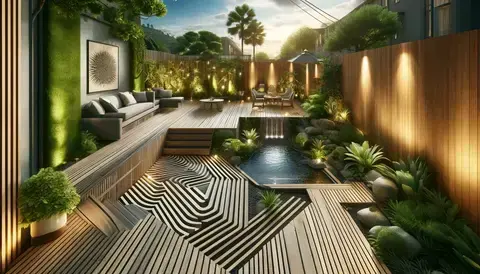
Here are over 40 ideas for DIY projects using composite decking, ranging from functional to decorative, indoor to outdoor. Each idea is a potential standalone project that we'll explore in future detailed articles.
Outdoor Living
- Decking for a Small Garden: Maximize space with a multi-level design.
- Built-In Seating Area: Create a cozy corner for relaxation.
- Planter Boxes: Durable planters for your garden or balcony.
- Outdoor Kitchen: Build a weather-resistant kitchen area.
- Fire Pit Surround: Safe and stylish area for your fire pit.
- Swing or Hammock Stand: Sturdy base for relaxing outdoor swings.
- Garden Paths: Use decking for durable, slip-resistant paths.
Furniture & Decor
- Sun Loungers: Design comfortable, weather-resistant loungers.
- Outdoor Dining Table: Create a large table for family gatherings.
- Coffee Tables: Small tables for drinks and snacks.
- Side Tables: Perfect for holding plants or outdoor lamps.
- Outdoor Bar: A fun addition to any decking area.
- Storage Bench: Seating that doubles as storage space.
- Garden Bench: A simple bench for any outdoor spot.
Functional Projects
- Storage Box: For cushions, toys, or gardening tools.
- Dog House: A comfortable, weather-proof retreat for pets.
- Birdhouses: Durable homes for your feathered friends.
- Bike Rack: Keep bikes secure and tidy.
- Waste Bin Storage: Hide bins stylishly.
- Outdoor Shower: Ideal for poolside or back from the beach.
- Compost Bin: For eco-friendly garden waste disposal.
Decorative Touches
- Wall Art: Create outdoor murals or patterns.
- Privacy Screens: Stylishly separate areas of your garden.
- Garden Trellis: Support for climbing plants.
- Fence Decor: Add visual interest to plain fences.
- Deck Lighting: Safe, attractive lighting solutions.
- Outdoor Signage: Welcome signs or house numbers.
- Wind Chimes: Add sound and movement to your garden.
Kids' Projects
- Playhouse: Safe and durable play area for children.
- Sandbox: With a cover to keep it clean when not in use.
- Climbing Wall: Attach to the side of a sturdy structure.
- Outdoor Games: Create pieces for giant board games.
- Sports Equipment Storage: Organize balls, bats, and more.
Unusual Ideas

- Floating Deck: For a pond or pool.
- Pet Ramp: Help older pets access your deck.
- Bee Hotels: Support biodiversity in your garden.
- Herb Spiral: A beautiful way to grow various herbs.
- Outdoor Library Box: Share books with your community.
- Yoga Platform: Peaceful spot for exercise and relaxation.
- Observation Deck: For nature watching or stargazing.
Conclusion and Next Steps
This section has introduced a wide array of DIY projects utilizing composite decking, each with the potential to add function, beauty, and value to your home. In future articles, we'll get into detailed guides for selected projects, providing step-by-step instructions, materials lists, and tips for success.
Composite Decking FAQ
Welcome to our detailed FAQ section, where we aim to provide comprehensive answers to commonly asked questions about composite decking. This guide caters to a wide audience, from homeowners considering decking options to professionals in the construction and landscaping industries. Our goal is to present information clearly and concisely, ensuring it's accessible and practical for your decision-making needs.
Expanded Composite Decking FAQ:
For more questions, please refer to our extensive list of Composite Decking Questions and Answers FAQ.
Questions and Answers
Composite Decking Basics
What is Composite Decking?
Composite decking is a durable, low-maintenance alternative to traditional wood decking. It's made from a mix of wood fibers and plastics, resulting in a product that withstands the elements better and requires less upkeep. Brands like Trex and TimberTech offer various colors and textures, catering to diverse outdoor design preferences.
What is the Number 1 Composite Decking?
Trex frequently tops the list for its quality, durability, and range of options. Known for its long-lasting nature, minimal maintenance, and eco-friendly makeup, Trex is a favored choice among both homeowners and professionals.
Composite Decking Comparison
Which is Stronger, PVC or Composite Decking?
Composite decking, which blends wood fibers and plastics, tends to offer superior toughness and flexibility, giving it an edge in strength and durability. PVC decking is highly moisture-resistant but may experience more thermal expansion and contraction.
Which is Better, Trex or Composite Decking?
Trex, itself a brand of composite decking, often stands out within the category for its high quality and durability. Comparing Trex to other composite decking brands involves considering factors like budget, aesthetic preferences, and project specifics.
Composite Decking Features and Benefits
What Are the Different Grades of Composite Decking?
Composite decking is categorized into entry-level, mid-range, and premium grades, each offering varying durability, aesthetics, and price points. Entry-level products are more affordable with fewer options, while premium products offer enhanced features and natural textures.
What is the Best Decking in the World?
Determining the "best" decking involves subjective criteria including durability, maintenance, and environmental impact. Trex, Timbertech, and Fiberon are often highlighted for their exceptional composite decking offerings.
Is Composite Decking Environmentally Friendly?
Many composite decking products are eco-friendly, utilizing recycled wood and plastic materials. This not only reduces waste but also limits the demand for new raw materials, contributing to environmental conservation.
Installation and Maintenance
Can Composite Decking Sit on Concrete?
Yes, with the proper setup involving a sleeper system or joists to ensure ventilation and drainage, composite decking can be installed over concrete, preventing moisture accumulation and damage.
How Do You Maintain Composite Decking?
Maintenance involves simple cleaning with soap and water to remove dirt. Unlike wood, it doesn’t require staining or sealing, although annual checks for any structural issues are advisable.
Cost Considerations
What is the Most Reasonably Priced Composite Decking?
Entry-level composite decking, like Trex Enhance Basics, offers a good balance of durability and affordability, providing the benefits of composite decking without the higher costs associated with premium grades.
Additional Considerations and Detailed Answers
How Does the Weather Affect Composite Decking Over Time?
Composite decking is designed to withstand various weather conditions, including extreme temperatures and moisture. However, minimal fading and expansion or contraction can occur with temperature fluctuations, though high-quality options are engineered to minimize these effects.
What are the Eco-Friendly Benefits of Composite Decking?
The use of recycled materials in manufacturing composite decking not only reduces waste but also conserves natural resources. This sustainable approach underscores the environmental benefits of choosing composite over traditional wood decking.
How to Properly Maintain Composite Decking to Extend Its Lifespan?
Regular cleaning to remove dirt and debris, along with periodic inspections to identify and address any potential issues, helps extend the lifespan of composite decking. Following the manufacturer's specific care instructions also plays a crucial role in maintenance.
Can Composite Decking Be Recycled at the End of Its Use?
Yes, the recyclability of composite decking at the end of its useful life varies by brand and product, but many manufacturers have programs to recycle old decking materials, underscoring the sustainability of composite decking solutions.
How Does the Cost of Composite Decking Compare to Traditional Wood Decking Over Time?
Though composite decking has a higher initial cost, its long-term value is evident in its durability and lower maintenance requirements. Over time, the investment in composite decking can prove more cost-effective than wood, which requires regular upkeep and replacement.
For more questions, please refer to our extensive list of Composite Decking Questions and Answers FAQ.
This FAQ aims to cover the breadth of questions related to composite decking, from basics and comparisons to specific features, costs, and maintenance tips. Whether planning a new deck or upgrading an existing one, these insights are designed to guide you through the process, ensuring a well-informed decision aligned with both aesthetic desires and practical considerations.
